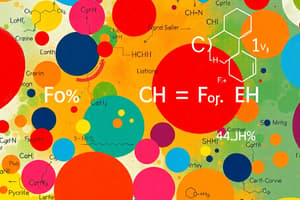Podcast
Questions and Answers
What is the ratio of the masses of oxygen that combine with a fixed mass of hydrogen to form water and hydrogen peroxide?
What is the ratio of the masses of oxygen that combine with a fixed mass of hydrogen to form water and hydrogen peroxide?
- 3:1
- 2:1
- 1:1
- 1:2 (correct)
What is the ratio of the volumes of hydrogen and oxygen that combine to form water vapor?
What is the ratio of the volumes of hydrogen and oxygen that combine to form water vapor?
- 2:1 (correct)
- 3:2
- 1:2
- 1:1
What is the name of the law that states that if two elements can combine to form more than one compound, the masses of one element that combine with a fixed mass of the other element are in the ratio of small whole numbers?
What is the name of the law that states that if two elements can combine to form more than one compound, the masses of one element that combine with a fixed mass of the other element are in the ratio of small whole numbers?
- Gay Lussac's law of gaseous volumes
- Law of definite proportions
- Law of multiple proportions (correct)
- Law of conservation of mass
According to Gay Lussac's law of gaseous volumes, what is the volume of water vapor formed when 100 mL of hydrogen combines with 50 mL of oxygen?
According to Gay Lussac's law of gaseous volumes, what is the volume of water vapor formed when 100 mL of hydrogen combines with 50 mL of oxygen?
What is the significance of Gay Lussac's discovery of the integer ratio in volume relationship?
What is the significance of Gay Lussac's discovery of the integer ratio in volume relationship?
Flashcards are hidden until you start studying
Study Notes
Percentage Composition of Elements
- The percentage composition of an element in a compound can be calculated using the formula: Mass % of an element = (mass of that element in the compound × 100) / molar mass of the compound
- Knowing the mass percentage of various elements present in a compound can help determine its empirical formula, and further, its molecular formula if the molar mass is known
Empirical and Molecular Formula
- An empirical formula represents the simplest whole number ratio of various atoms present in a compound
- A molecular formula shows the exact number of different types of atoms present in a molecule of a compound
Law of Definite Composition
- Also known as the Law of Constant Composition
- States that a chemical compound always contains the same proportion of elements by mass, regardless of its source or method of preparation
Law of Multiple Proportions
- Proposed by Dalton in 1803
- States that if two elements can combine to form more than one compound, the masses of one element that combine with a fixed mass of the other element are in the ratio of small whole numbers
Gay Lussac's Law of Gaseous Volumes
- Given by Gay Lussac in 1808
- States that when gases combine or are produced in a chemical reaction, they do so in a simple ratio by volume, provided all gases are at the same temperature and pressure
Calculation of Mass Percentage
- To calculate mass percentage, take 100 g of the compound as the starting material
- Divide the masses of each element by their respective atomic masses to get the number of moles of each element
- Divide each mole value by the smallest number amongst them to get the ratio of elements
- If the ratios are not whole numbers, convert them into whole numbers by multiplying by the suitable coefficient
Studying That Suits You
Use AI to generate personalized quizzes and flashcards to suit your learning preferences.




